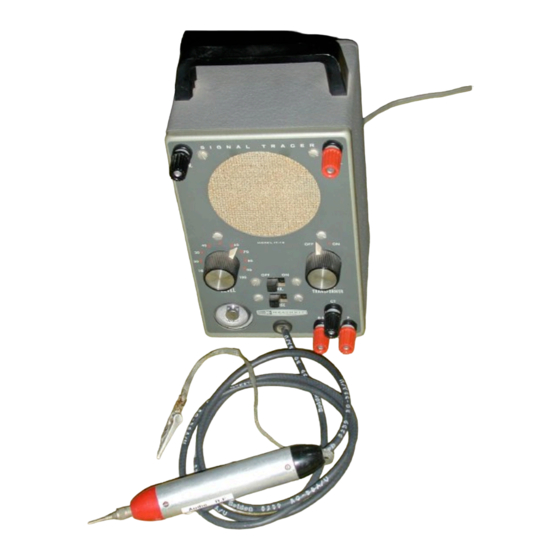Advertisement
Quick Links
HOM
Heathkit of the Month:
by Bob Eckweiler, AF6C
Heath IT-12
Visual - Aural Signal Tracer
Introduction:
This month we're going to look at a piece of in-
expensive Heathkit test equipment. If you ever
worked on a ham receiver or even an old AC-
DC radio, stereo or phonograph, the signal
tracer is second only to the voltmeter as a tool
for troubleshooting, especially if you don't own
a quality oscilloscope.
Heathkit IT-12 Signal Tracer
The Signal Tracer:
A signal tracer is a high-gain audio amplifier,
with a built-in speaker and visual signal indica-
tor. Two probes provide input to the signal
tracer. One probe directly connects the input
for troubleshooting audio signals. The second
probe includes a crystal diode for troubleshoot-
ing modulated R.F. signals. Often the probes
are combined into one probe with a two-
position switch for selecting the probe's func-
tion.
Copyright 2008 - 2010, R. Eckweiler & OCARC,
Heathkit of the Month #9 - IT-12 Signal Tracer
Using a Signal Tracer:
Using a signal tracer is quite simple. A signal
source is input to the 'device under test'
(DUT). For a receiver, a modulated RF signal
generator, or even a local radio station will
work. For an audio device, a record, tape, or
other audio signal is used. The DUT is then
probed one stage at a time. Thus it is easy to
find which stage is malfunctioning, whether it
is a total loss of signal, distortion, noise or low
gain. For example, to troubleshoot a super-
heterodyne shortwave receiver, first apply a
known RF signal. When the RF probe is placed
on the grid (or base) of the RF amplifier stage
you should hear the signal. The probe is then
moved to the plate (or collector) of the RF stage
and the signal checked again. If the stage has
gain you should notice it by the indicator and
the increase in signal volume. This procedure is
repeated in the mixer stage(s) and subsequent
IF stages. At the detector stage the audio probe
used instead of the RF probe and tracing con-
tinues. A sudden loss of signal or other prob-
lem tells which stage or interstage coupling is
at fault. From there it's usually a simple matter
to measure voltages and find the component
that is faulty.
Heathkit IT-12 Features:
The Heathkit IT-12 has a few additional fea-
tures that add to its capability. External termi-
nals are available for the speaker and the pri-
mary output transformer. Front panel switches
isolate the speaker and transformer so they can
the used for substitution in the device under
test. The speaker is handy for radios that don't
have built-in speakers.
A second feature that is very handy is the
NOISE feature. Sometimes components get
noisy and this can be very difficult to trace. Af-
ter you determine the stage where the noise is
originating using regular tracing techniques,
the DUT is turned off and the noise feature on
the IT-12 is turned on. This puts about 140
VDC (current limited) on the probe. When
touched to a component in the DUT a single
click is heard in the speaker of the IT-12. If the
Inc.
Page 1 of 3
Advertisement

Subscribe to Our Youtube Channel
Summary of Contents for Heathkit Heath IT-12
- Page 1 HOM Heathkit of the Month #9 - IT-12 Signal Tracer Heathkit of the Month: Using a Signal Tracer: Using a signal tracer is quite simple. A signal by Bob Eckweiler, AF6C source is input to the 'device under test' (DUT). For a receiver, a modulated RF signal generator, or even a local radio station will work.
- Page 2 Heathkit of the Month #9 - IT-12 Signal Tracer component being probed is intermittent or Heathkit T-3: breaking down, the noise is continuous and When Heathkit introduced the T-3 Signal that component needs to be replaced. This Tracer in 1952 they made many significant method can even detect cold soldered joints.
- Page 3 HOM Heathkit of the Month #9 - IT-12 Signal Tracer 5282 Audio Oscillator, IT-5283 Signal Tracer, with one warning. The noise circuit can dam- and IM-5284 Multimeter. When Heathkit went age solid state and low-voltage components if out of the kit business only two of these kits used indiscriminately.





Need help?
Do you have a question about the Heath IT-12 and is the answer not in the manual?
Questions and answers